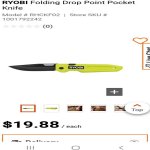Oh a fellow Albertan. Here's some stuff that has worked for me for Western AB hunts:
-- Knives. Don't get romantic. Just don't. Knives are a tool. You're going to lose one, or maybe five. (Trust me, you just are.) Get a Mora as your general knife. Run a Victorinox paring knife as your kill-kit knife. No, not a joke. I got annoyed with knives one day, and asked a trapper what he used (You know,
a guy who makes a living using a knife) and he pulled out a Vic. That killed the romance of knives for me. Pro-tip: Get the one with an orange handle, so that when you set it down in the grass, you can find it again. Total cost = $39, and this field knife/meat knife setup will do everything you could ever need for ANY hunting trip. Don't trip over Good Enough to chase the Perfection Unicorn.
-- Kill kit. You do have one of these, right? If not, get some pillow cases, your sparkly new Vic knife, a sharpener, some flag tape, some paracord, and a couple trash bags and stuff them into a stuff sack. Pow! Kill kit. Now you're ready to cut up your meat. As you hunt more, you can improve this kit as needed. (Read: Make it lighter.) Bone saw is not needed. But if you want a saw, buy a short hacksaw blade from home depot and wrap a bit of hockey tape around the blade as a handle. Voila: ultralight bone saw for $6.
-- Boots. Spend money here. Go try boots on. However, remember that heavy boots will wear you out way faster. I've switched to full-rand + leather approach shoes, paired with heavy OR gaiters. Light on your feet, but can handle rough terrain. I believe the stat was light shoes = 3.5mph vs heavy boots at 2mph. Most of us aren't running heavy mountain boots daily, and our bodies aren't conditioned for that. I guess if you're sheep hunting with a heavy pack, well, might be time for Hanwags or something like that. But for whitetail, some decent trail runners and solid gaiters will work really well. (I can hear the pearl clutching already.)
-- Pack. What are you running for a pack? Or rather: How are you planning on getting your meat out once you've shot this critter? Early season it's hot, and there is no snow. If you're in the backcountry, you either need a horse, or a pack frame of sorts to get the meat back to your truck and into coolers quickly. If you're truck hunting, canoe hunting, there's snow on the ground (sled), or have horses, it's a bit easier. Pro-tip: Always have a pack frame in your truck.
-- Meat. If you're a new hunter, do you know how to field-dress game? If you don't (I sure didn't) and you're solo-hunting, learn the Gutless Method. Randy Newberg has a great video on this. I downloaded it and had it saved to my phone a bunch of years ago as a reference. Helpful for a new guy if you're out on a mountain with a critter down and solo don't know what to do.
https://www.youtube.com/watch?v=Ny5z3kJWbn8 (Okay to be fair, you might know
what to do, but aren't quite sure
how to do it. Reference your bone saw comment.)
Anyway, that's about all I can think of for now. Best advice I can give: Don't get caught up with gear. I am a recovering gear head. I wasted a lot of time and money on not-hunting. Buying gear ISN'T field time. Spend your money on tags, and gas, and get to the field. Decent boots, a decent pack, and decent binos. Everything else is secondary,
especially rifles, and doesn't really matter to the hunt. (6.5x55 vs 30-06 is a rounding error. Dude, save your money and run your 6.5 for everything. The critter won't know the difference, whether that's deer, moose, elk, sheep, whatever.)










































































